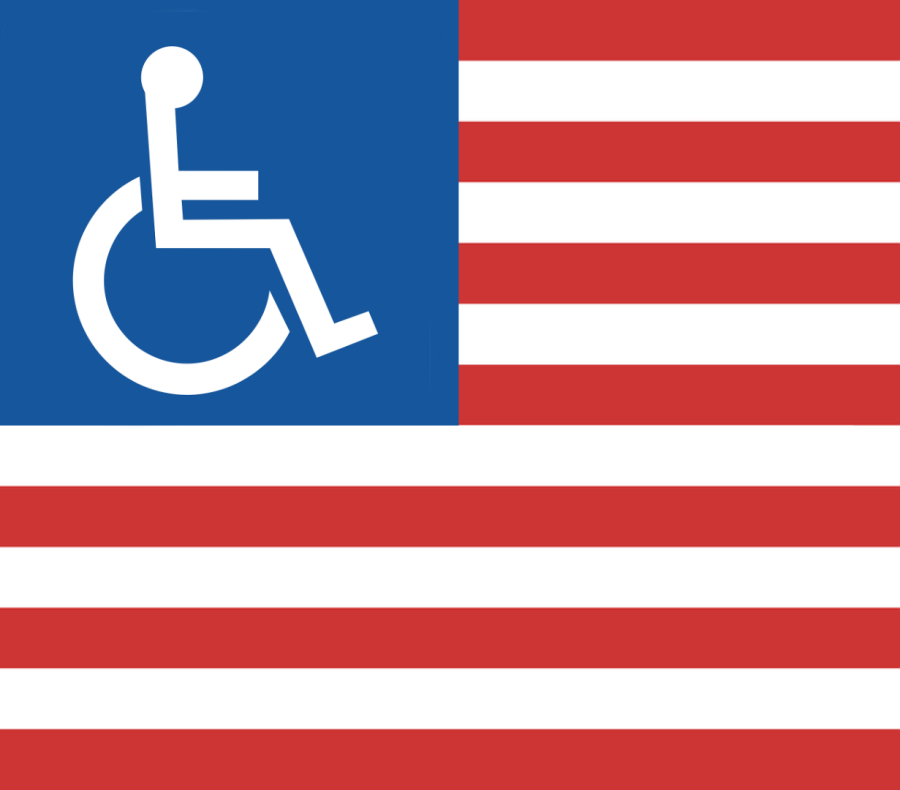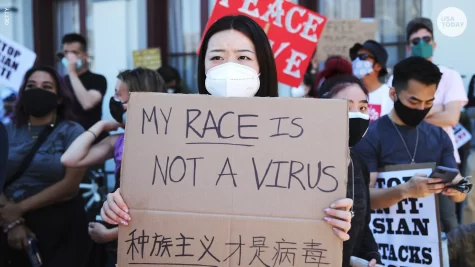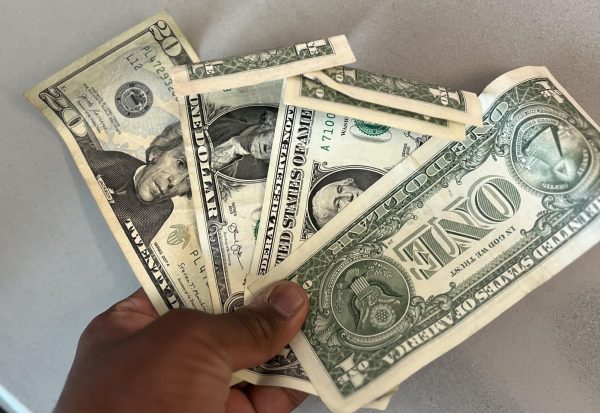Op-Ed: America is ableist
This story touches upon America’s long and complicated history with ableism.
Every other week, Pin Oak Middle School would section kids off into a variety of classrooms and shove surface-level messages of glorified kindness and vague acceptance down their throats. Whether it was a seminar on “loving thy neighbor as thyself”, or on the importance of not listening to the news as it will “only worry you”, my middle school had long lost my respect for the presentations that would happen during these short advocacy times. It was not often that I actually paid attention to whatever obvious morals my middle school tried to teach me in a twenty-minute period. However, that day, we were watching a video- one that caught my interest just enough for me to listen. It was about a family raising a teenager with severe cerebral palsy. Most of his body was paralyzed, and he spoke mainly in disconnected words and grunts. The video showed a, slightly patronizing at times, story of a family doing their best to “love and care” for a disabled family member.
It was about halfway through the video that one of my friends made a motion that implied that she had something to say to our table. I quickly turned my attention to her, captivated- I had a crush on her at the time, probably one of my first real and persistent ones. Everything she said was, to me, a stroke of genius that needed my full attention.
“If I had a son like that, I’d put him down.”
What?
She had said it with a smile and a laugh, as if what she had said was funny. Her statement was partially serious, partially said for shock value, and I haven’t stopped thinking about it since. At the time, I didn’t reply, too busy processing what she had just said. The table laughed and went back to watching the video.
If she had a son like that, she’d put him down.
‘That’ as in disabled, in need of accommodations, ‘put him down’ as in kill. Murder. Like an animal, like a dog, like something inhuman- or like something undeserving of humanity. I didn’t want to fully recognize it at the time, as I was still too infatuated with her, but as a Jewish girl and second-generation Holocaust survivor, I knew exactly what term could be applied to the situation.
Eugenics- “The study of how to arrange reproduction within a human population to increase the occurrence of heritable characteristics regarded as desirable”. One of the most well-known examples of eugenics in action is the Holocaust, Adolf Hitler and Nazi Germany’s gruesome and systemic murder of almost 12,000,000 people, about a quarter of a million of which were disabled people. People deemed “unworthy to live” due to the negative effects they may have on the future of Hitler’s Aryan race. The white, European, able-bodied Aryan race.
Later on, I would learn a term even more specific to the situation- ‘ableism’.
Ableism. Simply defined, “discrimination in favor of able-bodied people”.
“To me, it’s the assumption to the amount of things that I can do. I think it stems from a lack of exposure to people who are not necessarily always able to do stuff. I think people think ‘disabled’, and they have a very strict definition of that. But for me, I’m fine 90% of the time. The other 10%, I just kind of need help. I’m not, like, 100% disabled, I don’t even consider myself to be disabled, just temporarily handicapped,” replied Shir Carasso, a senior at CVHS, when questioned on how she would define ableism.
Carasso was born with a genetic condition labeled multiple hereditary exostoses. This condition is characterized by odd growths on the skeleton, which can cause bone misalignment, pain, and discomfort. Many with the condition, including Carasso, regularly undergo surgeries in order to remove the worst of these growths. While Carasso often functions like an able-bodied person, these surgeries usually leave her in wheelchairs, walkers, and other mobility aids for extended periods of time.

Mobility aids. Most have to use them at some point or another in their lives, whether that be a crutch to help one walk after spraining an ankle or a wheelchair after breaking a leg. Mobility aids are defined as “devices designed to help people who have problems moving around enjoy greater freedom and independence.” Almost seven million Americans use mobility aids daily, from senior citizens to teenagers and young adults such as Carasso- and to the uninsured American, the aids can be costly. Despite around 2,700,000 Americans using wheelchairs, a new one, on average, costs anywhere from $500 to $1000, and even insurance companies don’t usually cover the full cost. With a disproportionate number of disabled people living in poverty (29.5% to the abled percentage of 11.4%), the high cost of mobility aids can cause many issues, even without discussing the other issues that affect impoverished disabled people.
“Start off with like sidewalks honestly. Like, can you make sidewalks paved?” Carasso began with when asked how she would change America to make it more accessible.
It’s an experience most have had, simply regarded by most as an inconvenience or an aesthetic issue. You are taking a walk in a nice area- Rice Village, West University. The houses are large, the sidewalk is smooth and wide enough for multiple people to comfortably walk next to each other, and trees line it, providing you with shade on a nice day. As you walk further, the sidewalk gets bumpier, the trees begin to thin out. Modest one-stories and vacant lots begin to pop up in between McMansions, indications of the gentrification that took place here, likely pushing many people out of the area. Maybe, at one point, the sidewalk stops entirely and starts back up a couple of feet later, thin and cracked and old, with no shade. Oftentimes, this is where the average person chooses to turn back, where a bicyclist does a 180 in the face of an unrollable zone. This isn’t an option for the people that actually live on these streets. For disabled people in low-income communities, these sidewalks are entirely unnavigable, even with, especially with, mobility aids. A wheelchair can hardly roll on an uneven sidewalk, a walker can get stuck in a crack or a hole. Oftentimes, the sidewalks are much closer to the street, causing falling on them to be dangerous. Something as simple as taking a nice walk on a sunny day becomes inaccessible to the low-income disabled person.
Enjoying the outside isn’t the only simple thing lost to disabled and/or handicapped people. Something as simple as opening a door is often locked behind oversight, too.
“Just having a button to open the doors would have meant the world to me, so I didn’t have to flag down someone to help me. Moving the desks would have meant the world to me so that I could have space to roll or sit closer to the board in the classroom. That stuff makes such a big difference. Because when you’re living every day, those simple things are what really get to you,” said Carasso.
It is instances like these that exemplify the concept of systemic ableism. Ableism that exists, not just as a prejudice, but as something so ingrained into society that people do not notice it when it manifests. Lack of accommodations for disabled people, not on purpose, but because it was overlooked. Ableism as a result of ignorance is still ableism. Despite many efforts to fight against systemic ableism, there is only so much one can do to dismantle it- but great strides have been made by disabled people to do so, both socially and legally.
Throughout discussing accommodations schools such as CVHS, and other American buildings, could implement to make life easier for disabled people, Carasso continuously mentioned something called an ADA button, something we’ve all seen. ADA buttons are the little buttons often found to the side of doors, to open them for people who may otherwise have trouble doing so. They were named after the ADA act, which was passed into law by President George H.W. Bush on July 26th, 1990 due to the extensive efforts of hundreds of disabled Americans. The ADA act provided a variety of human rights to disabled people that they had been deprived of before- job protection, healthcare, protection from discrimination, and much more. However, while the ADA act succeeded in a variety of ways, many critic the inherent classism present throughout it- as, in order to receive many of its benefits, the disabled people making use of it must usually be impoverished. As an example, disabled people receiving SSDI (disability checks) are not allowed to make more than $1350 a month, creating a lose-lose situation for disabled people who wish to lift themselves up in life, but still receive extra help for healthcare and other necessities.
This unique financial turmoil placed on disabled people is only strengthened by both past and present legislatures. Way back in 1938, one of the most harmful laws to disabled people in American history would be signed into action, disguised within one of the most progressive labor reforms of its time. Section 14c of the Fair Labor Standards Act (FLSA) was a wrong painted as a right, and it goes like this: “Section 14(c) of the FLSA authorizes employers, after receiving a certificate from the Wage and Hour Division, to pay subminimum wages – wages less than the Federal minimum wage – to workers who have disabilities for the work being performed.” TL;DR: employers can legally pay disabled workers below the minimum wage if their disability hinders the work being done. This law, which is still in place today, is what enables American “sheltered” workshops– aka, sweatshops where disabled workers are legally paid a subminimum wage to do simple tasks, with no chance of rising the ranks, often in hazardous work environments. Ironically enough, FLSA was signed into law by Franklin D. Roosevelt, a disabled president who famously used a wheelchair to move. Sadly, this theme of disabled legislatures allowing ableism to thrive in the executive branch is not merely a thing of the past. But why?
“Let’s get one thing right. Greg Abbott is very rich and disabled. Just having two or three surgeries, getting treatment is very costly- and we live in America where healthcare sucks, especially for people who need it. Treatment is hard to access, and not cheap. So a lot of the stuff that could be more accessible to us costs money,” said Carasso.
It is no secret that just about anything is easier with money. Money provides better schooling, better housing- better healthcare. As aforementioned, a significantly higher percentage of disabled people live in poverty than able-bodied people. This also results in decreased access to healthcare, despite likely needing it more than the average able-bodied person. Lack of money leads to lack of healthcare, which means medical bills cost more, which means an even greater lack of money. Many disabled people have found themselves stuck in an economic system that seems almost designed to keep them down- and it seems elected officials such as Texas Governor Greg Abbott do not seem very inclined to break the status quo, despite being a wheelchair user himself.
“It’s like a loop- disabled people, in order to get their disability checks, can’t work more than 15 hours a week. Did you know that? They can’t work more than 15 hours a week, and they can be paid subpar minimum wage, and because of that, they can get their disability checks. That’s how, hopefully, they can pay for their medical bills. But it’s like a feedback loop, right? I want disability and therefore I have to get a job for less than 16 hours a week that’s gonna pay me like crap. So that way I can get a disability check so that way I can get my treatment. So that way, hopefully, this will be okay,” said Carasso.
In that way, even laws designed to help disabled people not only stay implicit in the systems that cause disproportionate poverty among disabled individuals, but actively aid in it. Ableism is engrained into American society, and no event in recent times has displayed that more explicitly than reactions to the COVID-19 pandemic.
Here’s a phrase you may have heard said happily, and probably not given it a second thought; “It’s unlikely for the average person to die of COVID-19, as it is usually only fatal to those with underlying health conditions.”
Hell, even the director of the CDC said it like it was a cause for celebration, granted, with a little more statistics and medical jargon: “The overwhelming number of [COVID-19] deaths, over 75%, occurred in people who had at least 4 comorbidities, so really these are people that were unwell to begin with. And yes, really encouraging news in the context of Omicron [to get vaccinated and boosted]. And yes we are really encouraged by these results.”
If you didn’t get that, Dr. Rochelle Walensky was attempting to encourage the average person by basically saying, “Don’t worry, you won’t die! But the millions of Americans who are immunocompromised will.” Immunocompromised Americans such as Carasso’s sister, such as my father.
One of the largest arguments against going back into quarantine, an idea prompted by the large spike in cases due to Omnicron, is that the “common” person needs to go back into society. Sure, the immunocompromised and the elderly will be put in danger, but the perfect “common” person is not elderly or immunocompromised. Why let the economy go up in flames just to protect a few people, why pause normal life for the “weak”. After all, survival of the fittest.
Eugenics.
That’s, once again, the word whispering into my ear whenever I have to listen to anti-masker, anti-vaxxers who’ve never once thought about the lives of anybody but themselves. Or when I have to listen to rich, powerful politicians who have the healthcare to survive the pandemic, the same healthcare they deprive the citizens they represent of.
Weeding out those who are supposedly weak, supposedly lesser, supposedly disposable, in order to create a “stronger” society and a “stronger” future bloodline, is at its core, eugenics.
Yet it is no big surprise that American politicians specifically are the ones most likely to perpetrate eugenic ideals, as the original concept of the Aryan race was actually created by “scientists” working for and paid by the American government. These pseudoscientists had legally sterilized and experimented on tens of thousands of Americans in the name of figuring out how to create the “master race” years before the Holocaust ever took place. Many of the subjects of these experiments were foreign immigrants, Jewish, and/or disabled. The American government even funded the initial research of many of the scientists that would go on to make the Holocaust as horrific as it was, such as Josef Mengele. Eugenics, as it existed in Nazi Germany, and as it often exists now, is quite literally an American concept.
“The whole idea behind the COVID-19 pandemic was the immunocompromised are the ones that are going to die. So we are all going to protect them, or at least that was the message that they wanted to send out. And now the message is, you are not immunocompromised, so, therefore, it doesn’t matter. And the voices of people who actually need that time and need that space are not being heard, and that’s not okay. Because there are people who are still dying. This is a pandemic,” said Carasso.
Your donation will support the student journalists of Carnegie Vanguard High School. Your contribution will allow us to cover our annual website hosting costs and fund field trips, competition fees, and equipment. We appreciate your support!

Danielle is a senior, as well as an activist for queer and feminist rights, which often makes its way into her writing. She is a family and friendship-oriented...











Nadia Talanker • Feb 18, 2022 at 2:28 pm
amazingly written article. the comparisons, word choice – everything in this article screams /powerful/. really loved this, wonderful job [:
Zainab Zaman • Feb 18, 2022 at 2:02 pm
I really liked your introduction and how you introduced the idea of ableism was brought up to the audience, it was like we were discovering it together.
Brooke Ferrell • Feb 18, 2022 at 1:59 pm
This is so so good!! I really love the second-to-last paragraph–the impact of eugenics being an ‘American concept’ is really strong. The article is so well-researched, it’s brilliant.